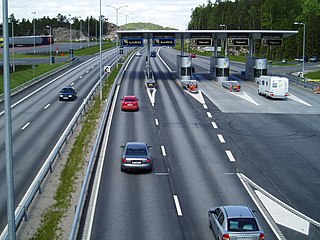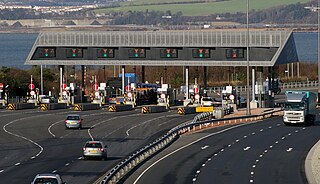 W
WThe car internal costs are all the costs consumers pay to own and operate a car. Normally these expenditures are divided by fixed or standing costs and variable or running costs. Fixed costs are those ones which do not depend on the distance traveled by the vehicle and which the owner must pay to keep the vehicle ready for use on the road, like insurance or road taxes. Variable or running costs are those that depend on the use of the car, like fuel or tolls.
 W
WThe externalities of automobiles, similarly to other economic externalities, are the measurable difference in costs for other parties to those of the car proprietor, such costs not taken into account when the proprietor opts to drive their car. According to Harvard University, the main externalities of driving are local and global pollution, oil dependence, traffic congestion and traffic accidents; while according to a meta-study conducted by the Delft University these externalities are congestion and scarcity costs, accident costs, air pollution costs, noise costs, climate change costs, costs for nature and landscape, costs for water pollution, costs for soil pollution and costs of energy dependency.
 W
WBroBizz is a Danish system for electronic toll collection. It was established in 2008 and BroBizz A/S develops and manages the concept. BroBizz A/S is 100% owned by Sund & Bælt Holding A/S.
 W
WThe Car Allowance Rebate System (CARS), colloquially known as "cash for clunkers", was a $3 billion U.S. federal scrappage program intended to provide economic incentives to U.S. residents to purchase a new, more fuel-efficient vehicle when trading in a less fuel-efficient vehicle. The program was promoted as a post-recession stimulus program to boost auto sales while putting more fuel-efficient vehicles on the roadways.
 W
WA car parking system is a mechanical device that multiplies parking capacity inside a parking lot. Parking systems are generally powered by electric motors or hydraulic pumps that move vehicles into a storage position.
 W
WEasyGo is a joint venture between Norway, Sweden, Denmark and Austria, that enables use of a single electronic toll tag on toll roads, ferries and bridges in all the member countries. The purpose of EasyGo is to enable the use of one OBE for payment when driving through any toll facility one might encounter on the way through Northern Europe and Austria.
 W
WElectronic toll collection (ETC) is a wireless system to automatically collect the usage fee or toll charged to vehicles using toll roads, HOV lanes, toll bridges, and toll tunnels. It is a faster alternative which is replacing toll booths, where vehicles must stop and the driver manually pays the toll with cash or a card. In most systems, vehicles using the system are equipped with an automated radio transponder device. When the vehicle passes a roadside toll reader device, a radio signal from the reader triggers the transponder, which transmits back an identifying number which registers the vehicle's use of the road, and an electronic payment system charges the user the toll. A major advantage is the driver does not have to stop, reducing traffic delays. Electronic tolling is cheaper than a staffed toll booth, reducing transaction costs for government or private road owners. The ease of varying the amount of the toll makes it easy to implement road congestion pricing, including for high-occupancy lanes, toll lanes that bypass congestion, and city-wide congestion charges. The payment system usually requires users to sign up in advance and load money into a declining-balance account, which is debited each time they pass a toll point.
 W
WThe fuel economy of an automobile relates distance traveled by a vehicle and the amount of fuel consumed. Consumption can be expressed in terms of volume of fuel to travel a distance, or the distance travelled per unit volume of fuel consumed. Since fuel consumption of vehicles is a significant factor in air pollution, and since importation of motor fuel can be a large part of a nation's foreign trade, many countries impose requirements for fuel economy. Different methods are used to approximate the actual performance of the vehicle. The energy in fuel is required to overcome various losses encountered while propelling the vehicle, and in providing power to vehicle systems such as ignition or air conditioning. Various strategies can be employed to reduce losses at each of the conversions between the chemical energy in the fuel and the kinetic energy of the vehicle. Driver behavior can affect fuel economy; maneuvers such as sudden acceleration and heavy braking waste energy.
 W
WThe usage and pricing of gasoline results from factors such as crude oil prices, processing and distribution costs, local demand, the strength of local currencies, local taxation, and the availability of local sources of gasoline (supply). Since fuels are traded worldwide, the trade prices are similar. The price paid by consumers largely reflects national pricing policy. Most countries impose taxes on gasoline (petrol), which causes air pollution and climate change; whereas a few, such as Venezuela, subsidize the cost. Some country's taxes do not cover all the negative externalities, that is they do not make the polluter pay the full cost. Western countries have among the highest usage rates per person. The largest consumer is the United States.
 W
WMiles per gallon gasoline equivalent is a measure of the average distance traveled per unit of energy consumed. MPGe is used by the United States Environmental Protection Agency (EPA) to compare energy consumption of alternative fuel vehicles, plug-in electric vehicles and other advanced technology vehicles with the energy consumption of conventional internal combustion vehicles rated in miles per U.S. gallon.
 W
WThe MOT test is an annual test of vehicle safety, roadworthiness aspects and exhaust emissions required in the United Kingdom for most vehicles over three years old. In Northern Ireland the equivalent requirement applies after four years. The requirement does not apply to vehicles used only on various small islands with no convenient connection "to a road in any part of Great Britain"; no similar exemption is listed at the beginning of 2014 for Northern Ireland, which has a single inhabited island, Rathlin. The MOT test was first introduced in 1960 as a few basic tests of a vehicle and now covers 20 different parts or systems on or in the car.
 W
WMotor Tax is an annual duty payable on motor vehicles in Ireland for use in public places. A new system for new private cars was introduced on 1 July 2008 where the tax rates are based on the carbon dioxide emissions of the car while in operation. Prior to this, tax rates are assessed on engine displacement - this includes used imports first registered in their original country of sale before July 2008. Motorcycles are all taxed the same regardless of engine displacement, with a special rate for electrically powered cycles. For goods vehicles, commercial vehicles and PSVs it is based on weight or is a standardised fee. For taxation of cars with Wankel engines under the old size-based system, the actual engine displacement is multiplied by 1.5 so for example a Mazda RX-8 with a 1.3 litre rotary engine is taxed as a 1.8 litre engined vehicle.
 W
WA parking meter is a device used to collect money in exchange for the right to park a vehicle in a particular place for a limited amount of time. Parking meters can be used by municipalities as a tool for enforcing their integrated on-street parking policy, usually related to their traffic and mobility management policies, but are also used for revenue.
 W
WRoad pricing are direct charges levied for the use of roads, including road tolls, distance or time based fees, congestion charges and charges designed to discourage use of certain classes of vehicle, fuel sources or more polluting vehicles. These charges may be used primarily for revenue generation, usually for road infrastructure financing, or as a transportation demand management tool to reduce peak hour travel and the associated traffic congestion or other social and environmental negative externalities associated with road travel such as air pollution, greenhouse gas emissions, visual intrusion, noise and road traffic collisions.
 W
WThe Stockholm congestion tax, also referred to as the Stockholm congestion charge, is a congestion pricing system implemented as a tax levied on most vehicles entering and exiting central Stockholm, Sweden. The congestion tax was implemented on a permanent basis on August 1, 2007, after a seven-month trial period between January 3, 2006 and July 31, 2006. It was inspired by Singapore's Electronic Road Pricing (ERP) system, which first introduced it in 1975.
 W
WA toll bridge is a bridge where a monetary charge is required to pass over. Generally the private or public owner, builder and maintainer of the bridge uses the toll to recoup their investment, in much the same way as a toll road.
 W
W W
WRoad tolling to finance bridges, tunnels and roads has a long history in Norway. The cities Oslo, Bergen and Trondheim introduced toll rings between 1986 and 1991 as a means to discourage urban traffic and to finance infrastructure projects around those cities. Today toll rings circumscribe Oslo, Kristiansand, Stavanger, Haugesund, Bergen, Askøy, Bodø, Harstad, Grenland, Førde and Trondheim. Besides toll rings, road tolls are installed to finance certain road projects, and often also on the existing road to discourage people from using it. Some tolls use congestion pricing and/or environmentally differentiated toll rates.
 W
WA traffic ticket is a notice issued by a law enforcement official to a motorist or other road user, indicating that the user has violated traffic laws. Traffic tickets generally come in two forms, citing a moving violation, such as exceeding the speed limit, or a non-moving violation, such as a parking violation, with the ticket also being referred to as a parking citation, or parking ticket.
 W
WIn the United States, vehicle safety inspection and emissions inspection are governed by each state individually. Fifteen states have a periodic safety inspection program, while Maryland requires a safety inspection and Alabama requires a VIN inspection on sale or transfer of vehicles which were previously registered in another state. An additional 16 states require periodic emissions inspections.
 W
WA car wash or auto wash is a facility used to clean the exterior and, in some cases, the interior of motor vehicles. Car washes can be self-service (DIY), full-service, or fully automated.